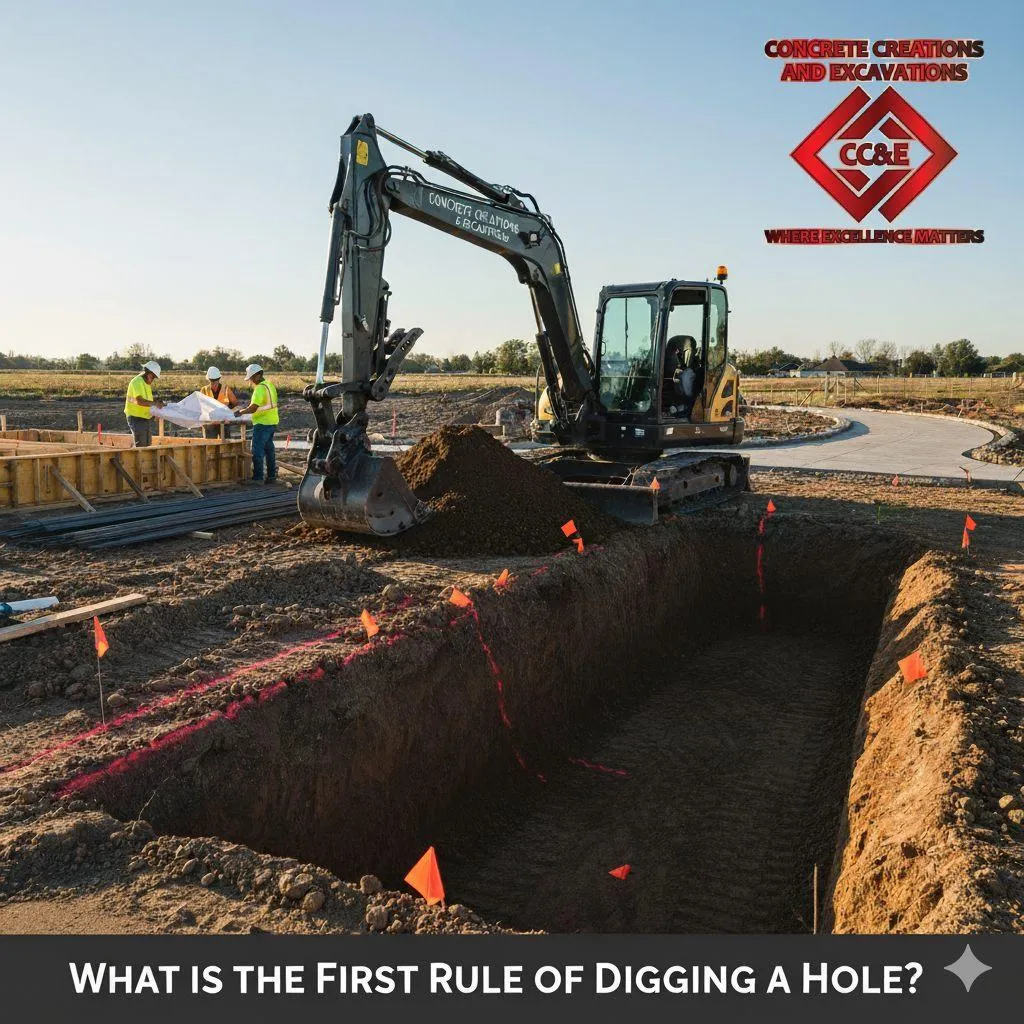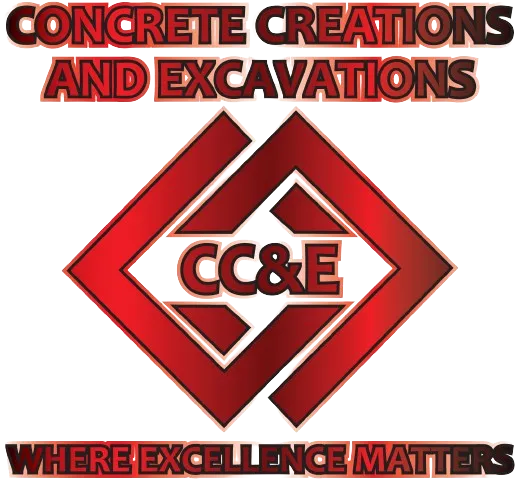Blog > Concrete Creations & Excavations Articles
Concrete Creations & Excavations Article Library
Welcome to the Concrete Creations & Excavations Blog Article Library, a valuable resource designed to connect homeowners like you with the world of concrete craftsmanship and innovation. Our blog serves as a hub for those seeking inspiration and information about the remarkable potential of concrete in transforming your living spaces. Whether you're planning a home improvement project, considering a renovation, or simply intrigued by the beauty of concrete, our library of articles is here to empower you with knowledge and insights. Join us on a journey of exploration as we unveil the incredible possibilities of concrete and showcase the exceptional creations that await you. At Concrete Creations & Excavations, we're not just a contractor; we're your partner in creating concrete masterpieces that enhance your home's beauty and functionality.


What is the first rule of digging a hole?
Digging a hole might seem like a straightforward task, but it carries significant risks and requires careful consideration. The first rule of digging a hole is simple yet crucial: always call before you dig to check for underground utilities. This principle, often summarized as "Call 811," prevents accidents, property damage, and legal issues that could arise from hitting gas lines, electrical cables, or water pipes.
Failing to adhere to this rule can lead to disastrous consequences, including explosions, electrocutions, or costly repairs. Whether you're a homeowner planning a garden project or a contractor handling large-scale excavation, understanding this foundational guideline sets the stage for safe and efficient work. In this article, we'll explore the depths of hole digging, from basics to advanced techniques, while highlighting professional services that can make the process seamless.
Understanding the Basics of Hole Digging
Hole digging has been a part of human activity since ancient times, used for everything from planting crops to constructing buildings. Today, it remains essential in construction, landscaping, and utility installation, but modern methods have evolved with technology and safety standards. Knowing the purpose of your hole—whether for a fence post, foundation, or drainage—helps determine the depth, width, and tools needed.
Before starting any dig, assess the soil type, as clay, sand, or rocky ground affects difficulty and stability. Soft soils might collapse easily, while hard terrains require more robust equipment. Always mark the area and gather necessary permits to ensure compliance with local regulations.
The History of Digging Techniques
Throughout history, humans have dug holes using rudimentary tools like sticks and stones, progressing to metal shovels during the Bronze Age. Ancient civilizations, such as the Egyptians and Romans, mastered large-scale excavation for pyramids and aqueducts, employing thousands of workers with basic levers and ramps. These early methods laid the groundwork for today's engineering marvels.
In the Industrial Revolution, steam-powered excavators revolutionized the field, allowing for deeper and faster digs. Modern excavation now incorporates hydraulic machinery, GPS-guided systems, and even robotic arms for precision. This evolution underscores the importance of adapting techniques to minimize risks and maximize efficiency.
Understanding historical contexts reminds us that while tools have advanced, the core principles—like planning and safety—remain timeless. Today's professionals build on this legacy to handle complex projects with expertise.
Why Planning is Essential Before Digging
Planning prevents poor performance, especially in digging where oversights can be hazardous. Start by sketching your project, measuring dimensions, and considering environmental factors like weather and terrain. Rain can turn a simple hole into a muddy mess, while frozen ground in winter demands specialized approaches.
Consult local authorities for zoning laws and utility maps, as unmarked lines pose serious threats. Incorporating a site survey ensures you avoid tree roots, septic systems, or archaeological sites that could halt progress. Thorough planning not only saves time but also reduces costs associated with unexpected complications.
For larger endeavors, enlisting experts can streamline this phase, providing insights that DIY efforts might miss. This is where reliable concrete companies come into play, offering guidance tailored to your needs.
The Role of Safety in Digging Operations
Safety isn't just a buzzword; it's the backbone of any digging project. Beyond calling 811, wear protective gear like gloves, helmets, and steel-toed boots to guard against injuries. For deeper holes, use shoring or trench boxes to prevent cave-ins, which account for numerous construction accidents annually.
Monitor for signs of instability, such as cracking soil or water seepage, and have an emergency plan in place. Training in first aid and equipment operation further enhances safety protocols. Remember, rushing leads to mistakes, so pace your work accordingly.
Professional teams prioritize these measures, ensuring compliance with OSHA standards and reducing liability. If safety concerns overwhelm you, turning to specialists can provide peace of mind.
Identifying Underground Utilities
Underground utilities are invisible threats that can turn a routine dig into a nightmare. Gas, electric, water, sewer, and telecom lines crisscross beneath our feet, often without surface indicators. The 811 service connects you to local utility companies who mark lines for free, typically within 48-72 hours.
Use hand tools for initial probing in marked areas to confirm locations gently. Advanced methods like ground-penetrating radar offer non-invasive detection for complex sites. Ignoring this step not only endangers lives but can result in hefty fines and service disruptions.
Companies skilled in excavation services employ these techniques routinely, minimizing risks and ensuring smooth project execution. Their experience in navigating utilities is invaluable for both residential and commercial jobs.
Tools and Equipment for Effective Digging
Choosing the right tools transforms digging from toil to task. For small holes, a shovel or post-hole digger suffices, with ergonomic designs reducing strain. Augers, powered by gas or electricity, speed up deeper digs like for fences or trees.
For extensive excavation, backhoes, mini-excavators, or skid steers handle heavy lifting efficiently. Attachments like buckets and breakers adapt to various soils and purposes. Maintenance is key—sharp blades and oiled parts prevent breakdowns and enhance performance.
Renting versus buying depends on project scale; frequent users might invest in quality gear. Professionals often have fleets of advanced equipment, ready for deployment on short notice.
Manual Digging Techniques
Manual digging relies on technique to conserve energy and avoid injury. Start with a proper stance: feet shoulder-width apart, knees bent, and back straight. Use your legs to lift soil, not your back, and alternate sides to balance effort.
For precision, outline the hole with stakes and string, then remove turf in sections. Layer by layer, loosen soil with a mattock before shoveling it out. In compacted earth, wetting slightly can ease the process without creating slop. While rewarding, manual methods suit small projects; larger ones benefit from mechanical aid to save time and labor.
Mechanical Digging Methods
Mechanical digging amplifies human capability, ideal for substantial projects. Excavators with rotating cabs allow 360-degree operation, digging trenches or foundations swiftly. Loaders move displaced soil efficiently, keeping sites organized.
Operators must be certified, understanding hydraulics and stability to prevent tip-overs. GPS integration ensures accurate depths and alignments, crucial for utilities or structures. Fuel efficiency and emission controls make modern machines environmentally friendlier. For those without access, hiring operators from reputable firms ensures expert handling without ownership hassles.
Soil Types and Their Impact on Digging
Soil composition dictates digging strategies profoundly. Sandy soils drain well but lack stability, prone to collapsing walls. Clay holds shape but resists penetration, often requiring picks or power tools to break through.
Loamy soils, a balanced mix, are easiest to work with, offering good drainage and cohesion. Rocky terrains demand hammers or explosives in extreme cases, increasing complexity and cost. Testing soil via samples informs amendments like adding gravel for better support. Experts analyze these factors during site assessments, recommending optimal approaches for durable results.
Environmental Considerations in Digging
Digging impacts the environment, from erosion to habitat disruption. Minimize disturbance by timing projects outside breeding seasons for wildlife and using silt fences to contain runoff. Replanting vegetation post-dig stabilizes soil and restores aesthetics.
Sustainable practices include recycling excavated material for fill elsewhere, reducing waste. Water conservation during wet digs prevents contamination of nearby streams. Regulatory compliance, like erosion control plans, safeguards ecosystems. Professional services often incorporate green methods, aligning with community standards for responsible development.
Legal and Regulatory Aspects
Navigating legalities is non-negotiable in digging. Permits vary by location and project size; failing to obtain them invites shutdowns and penalties. Building codes specify depths for foundations to withstand loads and frost lines.
Liability insurance protects against damages, especially near properties or roads. Environmental laws govern wetland disturbances or hazardous material handling. Staying informed through local offices or consultants avoids pitfalls. Firms versed in regional regulations handle paperwork seamlessly, allowing clients to focus on vision rather than bureaucracy.
Common Mistakes in Hole Digging
Novices often underestimate depth requirements, leading to unstable structures. Ignoring weather forecasts results in flooded holes or frozen tools, delaying timelines. Poor tool selection—using a spade for rocky soil—wastes effort and risks breakage.
Overlooking utility checks is the gravest error, as discussed. Inadequate shoring in trenches endangers workers with collapses. Rushing without measuring twice causes misalignments needing corrections. Learning from these pitfalls emphasizes the value of experience; pros sidestep them through proven protocols.
How to Avoid Cave-Ins and Collapses
Cave-ins occur when soil walls fail under pressure, often in unsupported trenches over four feet deep. Install shoring systems like hydraulic braces or aluminum panels to reinforce sides. Sloping or benching—cutting walls at angles—reduces risk in wider excavations.
Regular inspections detect early warning signs like fissures or bulging. Limit spoil piles near edges to avoid added weight. Training in recognition and response saves lives. Specialized contractors employ engineers for custom solutions, ensuring safety in challenging conditions.
Depth and Dimension Guidelines
Hole dimensions depend on purpose: post holes typically 2-3 times the post diameter, dug below frost line. Foundations require engineering specs for load-bearing, often 4-8 feet deep. Drainage pits vary by volume needs, ensuring percolation rates.
Use levels and tapes for accuracy, adjusting for backfill compaction. Over-digging allows for gravel bases enhancing stability. Guidelines from codes provide minima, but site-specific factors may demand more. Consultants calculate precisely, preventing over or under-engineering that compromises integrity.
Backfilling and Compaction Techniques
Backfilling restores the site post-dig. Use clean fill free of debris, layering in 6-12 inch lifts for even distribution. Compact each layer with tampers or rollers to eliminate voids, preventing settling.
Moisture content aids bonding; too dry crumbles, too wet slumps. Test density with probes for structural support. Vegetative backfill suits landscaping, while aggregate bolsters utilities. Experts compact methodically, guaranteeing longevity for overlying structures like driveways or patios.
Drainage and Water Management
Water accumulation undermines holes, eroding walls and weakening bases. Install French drains or sump pumps for persistent issues, directing flow away. Grading surfaces slopes water outward, preventing pooling.
In rainy climates, cover excavations with tarps during downtime. Permeable fabrics line walls to filter seepage without soil loss. Monitoring groundwater tables informs dewatering needs.
Professional planning integrates drainage from outset, averting costly retrofits. If you're seeking concrete companies near you, Concrete Creations & Excavations stands out with their expertise in managing water during projects.
Landscaping After Digging
Post-dig landscaping rejuvenates disturbed areas. Reseed grass or lay sod over compacted backfill, fertilizing for quick establishment. Plant shrubs or trees in prepared holes, mulching to retain moisture.
Incorporate features like retaining walls for sloped digs, enhancing usability. Irrigation systems buried during excavation promote healthy growth. Aesthetic touches like pathways tie the project together. Specialists in excavation services can coordinate landscaping, delivering turnkey transformations.
DIY vs. Professional Digging
DIY appeals for cost savings on small jobs, fostering satisfaction. However, lacking tools or know-how risks subpar results or injuries. Professionals bring efficiency, insurance, and warranties, offsetting higher upfront costs with quality.
For complex tasks like foundation work, pros are indispensable. Assess your skills honestly; simple post holes might be manageable, but trenches demand expertise. Turning to established concrete companies ensures professional outcomes without the hassle.
When to Call a Professional

Call professionals when projects exceed personal capacity, involve heavy machinery, or require permits. Signs include uncertain utility locations, challenging terrains, or tight deadlines. Budget for expertise to avoid rework expenses.
Reputable firms offer consultations, outlining scopes and estimates transparently. Their networks handle subcontractors seamlessly for multifaceted jobs. In Northwest Arkansas, Concrete Creations & Excavations provides reliable excavation services, ready to tackle your digging needs.
Benefits of Hiring Excavation Experts
Experts accelerate projects with specialized equipment, minimizing downtime. Their experience anticipates issues, from soil variances to weather impacts, ensuring adaptability. Insurance covers mishaps, protecting your investment.
Custom solutions tailor to site specifics, optimizing outcomes. Ongoing support post-completion addresses any settling or adjustments. Choosing Concrete Creations & Excavations means benefiting from over a decade of local knowledge in concrete and excavation.
Case Studies in Successful Digging Projects
One case involved a homeowner expanding a driveway; professionals excavated precisely, installing a sturdy concrete base that endured heavy use. Another featured commercial parking lot grading, where experts managed runoff effectively, preventing flooding.
In pool installations, accurate digging ensured proper drainage, avoiding future leaks. These examples highlight planning's role in success. Firms like Concrete Creations & Excavations have portfolios of such triumphs, showcasing their prowess.
Challenges in Urban Digging
Urban settings pose confined spaces, traffic disruptions, and dense utilities. Noise ordinances limit hours, while vibrations risk nearby structures. Coordinating with multiple stakeholders adds layers.
Solutions include compact machinery and phased approaches. Permits are stringent, demanding detailed plans. Urban specialists navigate these adeptly, maintaining community harmony.
Rural Digging Considerations
Rural digs contend with remote access, variable soils, and wildlife. Power sources might be limited, necessitating generators. Septic and well placements require careful siting.
Advantages include fewer restrictions and larger scales. Self-sufficiency is key, with backups for breakdowns. Local experts understand regional quirks, like Arkansas' clay-heavy grounds.
Innovations in Digging Technology
Drones survey sites aerially, mapping topography accurately. Autonomous excavators use AI for precise operations, reducing human error. 3D modeling simulates digs virtually, optimizing plans.
Sustainable tech like electric machines cuts emissions. Sensors detect utilities in real-time, enhancing safety. Adopting innovations keeps projects cutting-edge, as seen in forward-thinking concrete companies.
Future Trends in Excavation
Trends point to greener practices, with recycled materials and low-impact methods gaining traction. Robotics will automate routine tasks, boosting efficiency. Data analytics predict soil behaviors, refining techniques.
Integration with smart cities demands precise utility management. Training evolves with VR simulations. Staying ahead, professionals like those at Concrete Creations & Excavations embrace these for superior service.
Cost Factors in Digging Projects
Costs encompass labor, equipment, materials, and permits. Site accessibility influences transport fees, while soil type affects time. Depth and scale directly correlate with expenses.
Unexpected utilities or weather delays inflate budgets. Quotes from multiple providers ensure competitiveness. Transparent pricing from trusted excavation services helps in budgeting accurately.
Financing Options for Large Digs
Home equity loans fund residential projects, offering low rates. Contractor financing spreads payments, easing cash flow. Grants for eco-friendly digs might apply.
Compare terms, watching for hidden fees. Planning finances early avoids interruptions. Reputable firms assist with options, tailoring to client needs.
Maintenance After Digging
Maintain digs by inspecting for erosion or settling periodically. Seal concrete surfaces to repel water, extending life. Vegetation management prevents root intrusions.
For utilities, mark access points clearly. Annual checks by pros catch issues early. Ongoing care preserves investment, with services from concrete specialists ensuring durability.
Integrating Concrete Work with Digging
Digging often precedes concrete pouring, like for foundations or driveways. Proper excavation ensures level bases, preventing cracks. Grading directs water away, protecting integrity.
Stamped or stained concrete adds flair post-dig. Seamless integration yields functional beauty. Companies offering both, like Concrete Creations & Excavations, streamline processes for cohesive results.
Decorative Options Post-Excavation
Enhance excavated areas with decorative concrete, mimicking stone or wood affordably. Patios and walkways benefit from colors and textures, boosting curb appeal. Pool decks get non-slip finishes for safety.
Customization reflects personal style, increasing property value. Professionals advise on trends and maintenance. For stunning outcomes, consult local concrete experts near you.
Commercial vs. Residential Digging
Commercial digs scale larger, with stricter timelines and regulations. Heavy traffic demands robust designs, like reinforced parking lots. Coordination with architects is routine.
Residential focuses on aesthetics and functionality, like backyard features. Budgets vary, but safety remains paramount. Versatile firms handle both, adapting expertise accordingly.
Preparing for Weather Impacts
Weather dictates digging feasibility; schedule around forecasts. Cover materials to prevent soaking, and drain sites proactively. Cold snaps require heaters for concrete curing.
Flexibility in planning accommodates shifts. Pros monitor conditions, adjusting on the fly. In variable climates like Arkansas, local knowledge from excavation services is crucial.
Emergency Digging Scenarios
Emergencies like burst pipes demand swift action. Isolate hazards first, then excavate carefully to access. Have tools ready and contacts for utilities.
Post-repair, restore sites promptly. Training prepares for such events. Reliable contractors offer 24/7 response for urgent needs.
Community Impact of Digging Projects
Projects can enhance communities through improved infrastructure or green spaces. Minimize disruptions with signage and scheduling. Engage neighbors for input, fostering goodwill.
Positive outcomes include safer sidewalks or beautified parks. Sustainable approaches benefit long-term. Community-oriented firms prioritize harmonious execution.
Educational Resources on Digging
Books, online courses, and workshops teach digging fundamentals. Associations like ASCE offer certifications. YouTube tutorials demonstrate techniques visually.
Local extension services provide soil-specific advice. Continuous learning sharpens skills. For hands-on guidance, partner with experienced concrete companies.
Myths About Hole Digging Debunked
Myth: Deeper is always better—reality: Match depth to needs for stability without excess. Myth: Any shovel works—select based on soil and size.
Myth: Utilities are deep enough—many are shallow, necessitating checks. Dispelling these promotes safer practices.Experts clarify misconceptions, ensuring informed decisions.
The Psychological Aspects of Digging
Digging satisfies primal urges, offering therapeutic release through physical labor. Accomplishment from completion boosts morale. However, frustration from setbacks tests patience.
Team digs build camaraderie. Mindful approaches enhance enjoyment. For stress-free experiences, delegate to pros.
Global Perspectives on Excavation
Internationally, digging varies by culture and tech. In developing areas, manual labor prevails; advanced nations use automation. Regulations differ, with some emphasizing heritage preservation.
Learning from global methods enriches local practices. Innovations cross borders, improving standards. Adaptable services incorporate best practices worldwide.
Sustainability in Modern Digging
Sustainability focuses on minimal impact, using biodegradable lubricants and electric tools. Reusing soil reduces landfill contributions. Carbon footprint calculations guide greener choices.
Certifications like LEED reward eco-efforts. Future digs will prioritize regeneration.Eco-conscious concrete companies lead in sustainable excavation.
Conclusion: Embracing the First Rule
Revisiting the first rule—always call before you dig—encapsulates the essence of responsible hole digging. This article has delved into techniques, safety, and innovations, underscoring planning's pivotal role. Whether DIY or pro-assisted, adherence ensures success.
For your next project, consider Concrete Creations & Excavations, experts in concrete and excavation services near you. Visit https://www.concretecreationsandexcavations.com/ or call 479-341-5542 to transform your ideas into reality.
Contact Us
Service Hours
Social Media
2025 | Concrete Creations & Excavations | Rights Reserved
Owned and Operated by JD's Concrete Creations LLC
Powered By: House Reno Profits
Blog > Concrete Creations & Excavations Article Library
Concrete Creations & Excavations Article Library

Welcome to the Concrete Creations & Excavations Blog Article Library, a valuable resource designed to connect homeowners like you with the world of concrete craftsmanship and innovation. Our blog serves as a hub for those seeking inspiration and information about the remarkable potential of concrete in transforming your living spaces. Whether you're planning a home improvement project, considering a renovation, or simply intrigued by the beauty of concrete, our library of articles is here to empower you with knowledge and insights. Join us on a journey of exploration as we unveil the incredible possibilities of concrete and showcase the exceptional creations that await you. At Concrete Creations & Excavations, we're not just a contractor; we're your partner in creating concrete masterpieces that enhance your home's beauty and functionality.

What is the first rule of digging a hole?
Digging a hole might seem like a straightforward task, but it carries significant risks and requires careful consideration. The first rule of digging a hole is simple yet crucial: always call before you dig to check for underground utilities. This principle, often summarized as "Call 811," prevents accidents, property damage, and legal issues that could arise from hitting gas lines, electrical cables, or water pipes.
Failing to adhere to this rule can lead to disastrous consequences, including explosions, electrocutions, or costly repairs. Whether you're a homeowner planning a garden project or a contractor handling large-scale excavation, understanding this foundational guideline sets the stage for safe and efficient work. In this article, we'll explore the depths of hole digging, from basics to advanced techniques, while highlighting professional services that can make the process seamless.
Understanding the Basics of Hole Digging
Hole digging has been a part of human activity since ancient times, used for everything from planting crops to constructing buildings. Today, it remains essential in construction, landscaping, and utility installation, but modern methods have evolved with technology and safety standards. Knowing the purpose of your hole—whether for a fence post, foundation, or drainage—helps determine the depth, width, and tools needed.
Before starting any dig, assess the soil type, as clay, sand, or rocky ground affects difficulty and stability. Soft soils might collapse easily, while hard terrains require more robust equipment. Always mark the area and gather necessary permits to ensure compliance with local regulations.
The History of Digging Techniques
Throughout history, humans have dug holes using rudimentary tools like sticks and stones, progressing to metal shovels during the Bronze Age. Ancient civilizations, such as the Egyptians and Romans, mastered large-scale excavation for pyramids and aqueducts, employing thousands of workers with basic levers and ramps. These early methods laid the groundwork for today's engineering marvels.
In the Industrial Revolution, steam-powered excavators revolutionized the field, allowing for deeper and faster digs. Modern excavation now incorporates hydraulic machinery, GPS-guided systems, and even robotic arms for precision. This evolution underscores the importance of adapting techniques to minimize risks and maximize efficiency.
Understanding historical contexts reminds us that while tools have advanced, the core principles—like planning and safety—remain timeless. Today's professionals build on this legacy to handle complex projects with expertise.
Why Planning is Essential Before Digging
Planning prevents poor performance, especially in digging where oversights can be hazardous. Start by sketching your project, measuring dimensions, and considering environmental factors like weather and terrain. Rain can turn a simple hole into a muddy mess, while frozen ground in winter demands specialized approaches.
Consult local authorities for zoning laws and utility maps, as unmarked lines pose serious threats. Incorporating a site survey ensures you avoid tree roots, septic systems, or archaeological sites that could halt progress. Thorough planning not only saves time but also reduces costs associated with unexpected complications.
For larger endeavors, enlisting experts can streamline this phase, providing insights that DIY efforts might miss. This is where reliable concrete companies come into play, offering guidance tailored to your needs.
The Role of Safety in Digging Operations
Safety isn't just a buzzword; it's the backbone of any digging project. Beyond calling 811, wear protective gear like gloves, helmets, and steel-toed boots to guard against injuries. For deeper holes, use shoring or trench boxes to prevent cave-ins, which account for numerous construction accidents annually.
Monitor for signs of instability, such as cracking soil or water seepage, and have an emergency plan in place. Training in first aid and equipment operation further enhances safety protocols. Remember, rushing leads to mistakes, so pace your work accordingly.
Professional teams prioritize these measures, ensuring compliance with OSHA standards and reducing liability. If safety concerns overwhelm you, turning to specialists can provide peace of mind.
Identifying Underground Utilities
Underground utilities are invisible threats that can turn a routine dig into a nightmare. Gas, electric, water, sewer, and telecom lines crisscross beneath our feet, often without surface indicators. The 811 service connects you to local utility companies who mark lines for free, typically within 48-72 hours.
Use hand tools for initial probing in marked areas to confirm locations gently. Advanced methods like ground-penetrating radar offer non-invasive detection for complex sites. Ignoring this step not only endangers lives but can result in hefty fines and service disruptions.
Companies skilled in excavation services employ these techniques routinely, minimizing risks and ensuring smooth project execution. Their experience in navigating utilities is invaluable for both residential and commercial jobs.
Tools and Equipment for Effective Digging
Choosing the right tools transforms digging from toil to task. For small holes, a shovel or post-hole digger suffices, with ergonomic designs reducing strain. Augers, powered by gas or electricity, speed up deeper digs like for fences or trees.
For extensive excavation, backhoes, mini-excavators, or skid steers handle heavy lifting efficiently. Attachments like buckets and breakers adapt to various soils and purposes. Maintenance is key—sharp blades and oiled parts prevent breakdowns and enhance performance.
Renting versus buying depends on project scale; frequent users might invest in quality gear. Professionals often have fleets of advanced equipment, ready for deployment on short notice.
Manual Digging Techniques
Manual digging relies on technique to conserve energy and avoid injury. Start with a proper stance: feet shoulder-width apart, knees bent, and back straight. Use your legs to lift soil, not your back, and alternate sides to balance effort.
For precision, outline the hole with stakes and string, then remove turf in sections. Layer by layer, loosen soil with a mattock before shoveling it out. In compacted earth, wetting slightly can ease the process without creating slop. While rewarding, manual methods suit small projects; larger ones benefit from mechanical aid to save time and labor.
Mechanical Digging Methods
Mechanical digging amplifies human capability, ideal for substantial projects. Excavators with rotating cabs allow 360-degree operation, digging trenches or foundations swiftly. Loaders move displaced soil efficiently, keeping sites organized.
Operators must be certified, understanding hydraulics and stability to prevent tip-overs. GPS integration ensures accurate depths and alignments, crucial for utilities or structures. Fuel efficiency and emission controls make modern machines environmentally friendlier. For those without access, hiring operators from reputable firms ensures expert handling without ownership hassles.
Soil Types and Their Impact on Digging
Soil composition dictates digging strategies profoundly. Sandy soils drain well but lack stability, prone to collapsing walls. Clay holds shape but resists penetration, often requiring picks or power tools to break through.
Loamy soils, a balanced mix, are easiest to work with, offering good drainage and cohesion. Rocky terrains demand hammers or explosives in extreme cases, increasing complexity and cost. Testing soil via samples informs amendments like adding gravel for better support. Experts analyze these factors during site assessments, recommending optimal approaches for durable results.
Environmental Considerations in Digging
Digging impacts the environment, from erosion to habitat disruption. Minimize disturbance by timing projects outside breeding seasons for wildlife and using silt fences to contain runoff. Replanting vegetation post-dig stabilizes soil and restores aesthetics.
Sustainable practices include recycling excavated material for fill elsewhere, reducing waste. Water conservation during wet digs prevents contamination of nearby streams. Regulatory compliance, like erosion control plans, safeguards ecosystems. Professional services often incorporate green methods, aligning with community standards for responsible development.
Legal and Regulatory Aspects
Navigating legalities is non-negotiable in digging. Permits vary by location and project size; failing to obtain them invites shutdowns and penalties. Building codes specify depths for foundations to withstand loads and frost lines.
Liability insurance protects against damages, especially near properties or roads. Environmental laws govern wetland disturbances or hazardous material handling. Staying informed through local offices or consultants avoids pitfalls. Firms versed in regional regulations handle paperwork seamlessly, allowing clients to focus on vision rather than bureaucracy.
Common Mistakes in Hole Digging
Novices often underestimate depth requirements, leading to unstable structures. Ignoring weather forecasts results in flooded holes or frozen tools, delaying timelines. Poor tool selection—using a spade for rocky soil—wastes effort and risks breakage.
Overlooking utility checks is the gravest error, as discussed. Inadequate shoring in trenches endangers workers with collapses. Rushing without measuring twice causes misalignments needing corrections. Learning from these pitfalls emphasizes the value of experience; pros sidestep them through proven protocols.
How to Avoid Cave-Ins and Collapses
Cave-ins occur when soil walls fail under pressure, often in unsupported trenches over four feet deep. Install shoring systems like hydraulic braces or aluminum panels to reinforce sides. Sloping or benching—cutting walls at angles—reduces risk in wider excavations.
Regular inspections detect early warning signs like fissures or bulging. Limit spoil piles near edges to avoid added weight. Training in recognition and response saves lives. Specialized contractors employ engineers for custom solutions, ensuring safety in challenging conditions.
Depth and Dimension Guidelines
Hole dimensions depend on purpose: post holes typically 2-3 times the post diameter, dug below frost line. Foundations require engineering specs for load-bearing, often 4-8 feet deep. Drainage pits vary by volume needs, ensuring percolation rates.
Use levels and tapes for accuracy, adjusting for backfill compaction. Over-digging allows for gravel bases enhancing stability. Guidelines from codes provide minima, but site-specific factors may demand more. Consultants calculate precisely, preventing over or under-engineering that compromises integrity.
Backfilling and Compaction Techniques
Backfilling restores the site post-dig. Use clean fill free of debris, layering in 6-12 inch lifts for even distribution. Compact each layer with tampers or rollers to eliminate voids, preventing settling.
Moisture content aids bonding; too dry crumbles, too wet slumps. Test density with probes for structural support. Vegetative backfill suits landscaping, while aggregate bolsters utilities. Experts compact methodically, guaranteeing longevity for overlying structures like driveways or patios.
Drainage and Water Management
Water accumulation undermines holes, eroding walls and weakening bases. Install French drains or sump pumps for persistent issues, directing flow away. Grading surfaces slopes water outward, preventing pooling.
In rainy climates, cover excavations with tarps during downtime. Permeable fabrics line walls to filter seepage without soil loss. Monitoring groundwater tables informs dewatering needs.
Professional planning integrates drainage from outset, averting costly retrofits. If you're seeking concrete companies near you, Concrete Creations & Excavations stands out with their expertise in managing water during projects.
Landscaping After Digging
Post-dig landscaping rejuvenates disturbed areas. Reseed grass or lay sod over compacted backfill, fertilizing for quick establishment. Plant shrubs or trees in prepared holes, mulching to retain moisture.
Incorporate features like retaining walls for sloped digs, enhancing usability. Irrigation systems buried during excavation promote healthy growth. Aesthetic touches like pathways tie the project together. Specialists in excavation services can coordinate landscaping, delivering turnkey transformations.
DIY vs. Professional Digging
DIY appeals for cost savings on small jobs, fostering satisfaction. However, lacking tools or know-how risks subpar results or injuries. Professionals bring efficiency, insurance, and warranties, offsetting higher upfront costs with quality.
For complex tasks like foundation work, pros are indispensable. Assess your skills honestly; simple post holes might be manageable, but trenches demand expertise. Turning to established concrete companies ensures professional outcomes without the hassle.
When to Call a Professional

Call professionals when projects exceed personal capacity, involve heavy machinery, or require permits. Signs include uncertain utility locations, challenging terrains, or tight deadlines. Budget for expertise to avoid rework expenses.
Reputable firms offer consultations, outlining scopes and estimates transparently. Their networks handle subcontractors seamlessly for multifaceted jobs. In Northwest Arkansas, Concrete Creations & Excavations provides reliable excavation services, ready to tackle your digging needs.
Benefits of Hiring Excavation Experts
Experts accelerate projects with specialized equipment, minimizing downtime. Their experience anticipates issues, from soil variances to weather impacts, ensuring adaptability. Insurance covers mishaps, protecting your investment.
Custom solutions tailor to site specifics, optimizing outcomes. Ongoing support post-completion addresses any settling or adjustments. Choosing Concrete Creations & Excavations means benefiting from over a decade of local knowledge in concrete and excavation.
Case Studies in Successful Digging Projects
One case involved a homeowner expanding a driveway; professionals excavated precisely, installing a sturdy concrete base that endured heavy use. Another featured commercial parking lot grading, where experts managed runoff effectively, preventing flooding.
In pool installations, accurate digging ensured proper drainage, avoiding future leaks. These examples highlight planning's role in success. Firms like Concrete Creations & Excavations have portfolios of such triumphs, showcasing their prowess.
Challenges in Urban Digging
Urban settings pose confined spaces, traffic disruptions, and dense utilities. Noise ordinances limit hours, while vibrations risk nearby structures. Coordinating with multiple stakeholders adds layers.
Solutions include compact machinery and phased approaches. Permits are stringent, demanding detailed plans. Urban specialists navigate these adeptly, maintaining community harmony.
Rural Digging Considerations
Rural digs contend with remote access, variable soils, and wildlife. Power sources might be limited, necessitating generators. Septic and well placements require careful siting.
Advantages include fewer restrictions and larger scales. Self-sufficiency is key, with backups for breakdowns. Local experts understand regional quirks, like Arkansas' clay-heavy grounds.
Innovations in Digging Technology
Drones survey sites aerially, mapping topography accurately. Autonomous excavators use AI for precise operations, reducing human error. 3D modeling simulates digs virtually, optimizing plans.
Sustainable tech like electric machines cuts emissions. Sensors detect utilities in real-time, enhancing safety. Adopting innovations keeps projects cutting-edge, as seen in forward-thinking concrete companies.
Future Trends in Excavation
Trends point to greener practices, with recycled materials and low-impact methods gaining traction. Robotics will automate routine tasks, boosting efficiency. Data analytics predict soil behaviors, refining techniques.
Integration with smart cities demands precise utility management. Training evolves with VR simulations. Staying ahead, professionals like those at Concrete Creations & Excavations embrace these for superior service.
Cost Factors in Digging Projects
Costs encompass labor, equipment, materials, and permits. Site accessibility influences transport fees, while soil type affects time. Depth and scale directly correlate with expenses.
Unexpected utilities or weather delays inflate budgets. Quotes from multiple providers ensure competitiveness. Transparent pricing from trusted excavation services helps in budgeting accurately.
Financing Options for Large Digs
Home equity loans fund residential projects, offering low rates. Contractor financing spreads payments, easing cash flow. Grants for eco-friendly digs might apply.
Compare terms, watching for hidden fees. Planning finances early avoids interruptions. Reputable firms assist with options, tailoring to client needs.
Maintenance After Digging
Maintain digs by inspecting for erosion or settling periodically. Seal concrete surfaces to repel water, extending life. Vegetation management prevents root intrusions.
For utilities, mark access points clearly. Annual checks by pros catch issues early. Ongoing care preserves investment, with services from concrete specialists ensuring durability.
Integrating Concrete Work with Digging
Digging often precedes concrete pouring, like for foundations or driveways. Proper excavation ensures level bases, preventing cracks. Grading directs water away, protecting integrity.
Stamped or stained concrete adds flair post-dig. Seamless integration yields functional beauty. Companies offering both, like Concrete Creations & Excavations, streamline processes for cohesive results.
Decorative Options Post-Excavation
Enhance excavated areas with decorative concrete, mimicking stone or wood affordably. Patios and walkways benefit from colors and textures, boosting curb appeal. Pool decks get non-slip finishes for safety.
Customization reflects personal style, increasing property value. Professionals advise on trends and maintenance. For stunning outcomes, consult local concrete experts near you.
Commercial vs. Residential Digging
Commercial digs scale larger, with stricter timelines and regulations. Heavy traffic demands robust designs, like reinforced parking lots. Coordination with architects is routine.
Residential focuses on aesthetics and functionality, like backyard features. Budgets vary, but safety remains paramount. Versatile firms handle both, adapting expertise accordingly.
Preparing for Weather Impacts
Weather dictates digging feasibility; schedule around forecasts. Cover materials to prevent soaking, and drain sites proactively. Cold snaps require heaters for concrete curing.
Flexibility in planning accommodates shifts. Pros monitor conditions, adjusting on the fly. In variable climates like Arkansas, local knowledge from excavation services is crucial.
Emergency Digging Scenarios
Emergencies like burst pipes demand swift action. Isolate hazards first, then excavate carefully to access. Have tools ready and contacts for utilities.
Post-repair, restore sites promptly. Training prepares for such events. Reliable contractors offer 24/7 response for urgent needs.
Community Impact of Digging Projects
Projects can enhance communities through improved infrastructure or green spaces. Minimize disruptions with signage and scheduling. Engage neighbors for input, fostering goodwill.
Positive outcomes include safer sidewalks or beautified parks. Sustainable approaches benefit long-term. Community-oriented firms prioritize harmonious execution.
Educational Resources on Digging
Books, online courses, and workshops teach digging fundamentals. Associations like ASCE offer certifications. YouTube tutorials demonstrate techniques visually.
Local extension services provide soil-specific advice. Continuous learning sharpens skills. For hands-on guidance, partner with experienced concrete companies.
Myths About Hole Digging Debunked
Myth: Deeper is always better—reality: Match depth to needs for stability without excess. Myth: Any shovel works—select based on soil and size.
Myth: Utilities are deep enough—many are shallow, necessitating checks. Dispelling these promotes safer practices.Experts clarify misconceptions, ensuring informed decisions.
The Psychological Aspects of Digging
Digging satisfies primal urges, offering therapeutic release through physical labor. Accomplishment from completion boosts morale. However, frustration from setbacks tests patience.
Team digs build camaraderie. Mindful approaches enhance enjoyment. For stress-free experiences, delegate to pros.
Global Perspectives on Excavation
Internationally, digging varies by culture and tech. In developing areas, manual labor prevails; advanced nations use automation. Regulations differ, with some emphasizing heritage preservation.
Learning from global methods enriches local practices. Innovations cross borders, improving standards. Adaptable services incorporate best practices worldwide.
Sustainability in Modern Digging
Sustainability focuses on minimal impact, using biodegradable lubricants and electric tools. Reusing soil reduces landfill contributions. Carbon footprint calculations guide greener choices.
Certifications like LEED reward eco-efforts. Future digs will prioritize regeneration.Eco-conscious concrete companies lead in sustainable excavation.
Conclusion: Embracing the First Rule
Revisiting the first rule—always call before you dig—encapsulates the essence of responsible hole digging. This article has delved into techniques, safety, and innovations, underscoring planning's pivotal role. Whether DIY or pro-assisted, adherence ensures success.
For your next project, consider Concrete Creations & Excavations, experts in concrete and excavation services near you. Visit https://www.concretecreationsandexcavations.com/ or call 479-341-5542 to transform your ideas into reality.
Contact Us
479-341-5542
Centerton, AR, 72719
Service Hours
Mon-Sat: 7am - 7pm
Sun: OFF
Social Media








